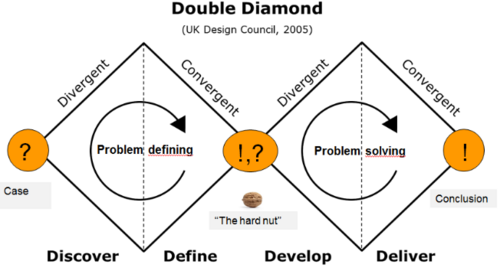The Double Diamond Tool: An efficient Project Management Tool
Developed by Wail Atrari
Abstract
This article will shed a light on a management tool called the Double Diamond process. The Double Diamond process covers a wide area of the problem-solving process. From discovering the initial problem to presenting a solve for this problem at the end of the process.
When managers are given a specific problem to solve, many managers quickly move on to the problem-solving phase, and try to solve that specific problem.[1]
This can result in the solution being only a temporary solution or being a solution to the wrong problem. And the reason for that, can be that not enough time has been spent on reviewing the actual problem and whether this problem is eligible. In other words, whether the so-called problem is the actual root of the problem. And this is where the Double Diamond tool will come in handy.
The Double Diamond tool was created by the Design Council in 2005, and consists of four smaller phases, which are utilized by special methods of thinking: Divergent and Convergent thinking, which this article will cover. The Double Diamond tool explores the problem to discover if the implied problem is the actual root problem or just a consequence of another problem. The Double Diamond tool forces the user to spend time on exploring the problem definition phase in order to discover the very source of the problem, before moving on to the problem-solving phases, which ensures that the correct problem is found and solved.[2]
This article will describe the Double Diamond tool in detail, as well as give a step-by-step guideline on how a manager of a project can apply this tool, in conjunction with other models and tools, in their projects.
Contents |
Introduction
The Double Diamond tool was developed in 2005, by a British organization called Design Council. The Double Diamond tool was the product of a research that had been conducted to observe the design process of some of the leading companies. The leading companies’ way of operating in the design processes had some similarities, and based on that research, The Double Diamond tool was invented.[3]
The Double Diamond tool is a powerful management tool that can be used in many situations and examples, and thus offer a flexible but still a very innovative way to handle management problems, obstacles, and challenges. The Double Diamond is a tool that motivates the user to think outside of the box, in a creative and innovative way, and thus explores new methods and approaches to a given problem. This can contribute to the problem-solving phases and customer needs.
Unlike most other tools or models that focuses, first and foremost, on the problem-solving phases, The Double Diamond tool also puts a lot of emphasis on the problem-identification process. This ensures that the user reflects sufficiently on the problem-definition process instead of rushing to find a solution. Is it the problem, the actual cause of the problem? Or merely a consequence of another deeper problem. This methodology can be very beneficial in order to find a more permanent and efficient approach or solution to a given problem or challenge.
The Double Diamond model consist of two diamonds, side by side. The First diamond symbolizes the problem-defining phase, which consists of the discover-phase, where a divergent thinking is prompted, followed by the convergent-thinking define-phase. The Second model symbolizes the problem-solving phase, which consists of the develop-phase, where a divergent thinking again is required, followed by the convergent-thinking of the deliver-phase. This article will explain how to use The Double Diamond tool, and how to use it in conjunction with other tools and models in order to achieve the most efficient result.
The problem defining phases
text
Discover
text
Define
text
The problem solving phases
text
Develop
text
Deliver
text
How to apply the double diamond tool in management situations
text
References
- ↑ [https://hbr.org/2017/01/are-you-solving-the-right-problems] Are you solving the right problems? - by Thomas Wedell-Wedellsborg
- ↑ [https://www.designcouncil.org.uk/sites/default/files/asset/document/ElevenLessons_Design_Council%20(2).pdf] A study of the design process - by Design Council
- ↑ [https://www.designcouncil.org.uk/sites/default/files/asset/document/ElevenLessons_Design_Council%20(2).pdf] A study of the design process - by Design Council
